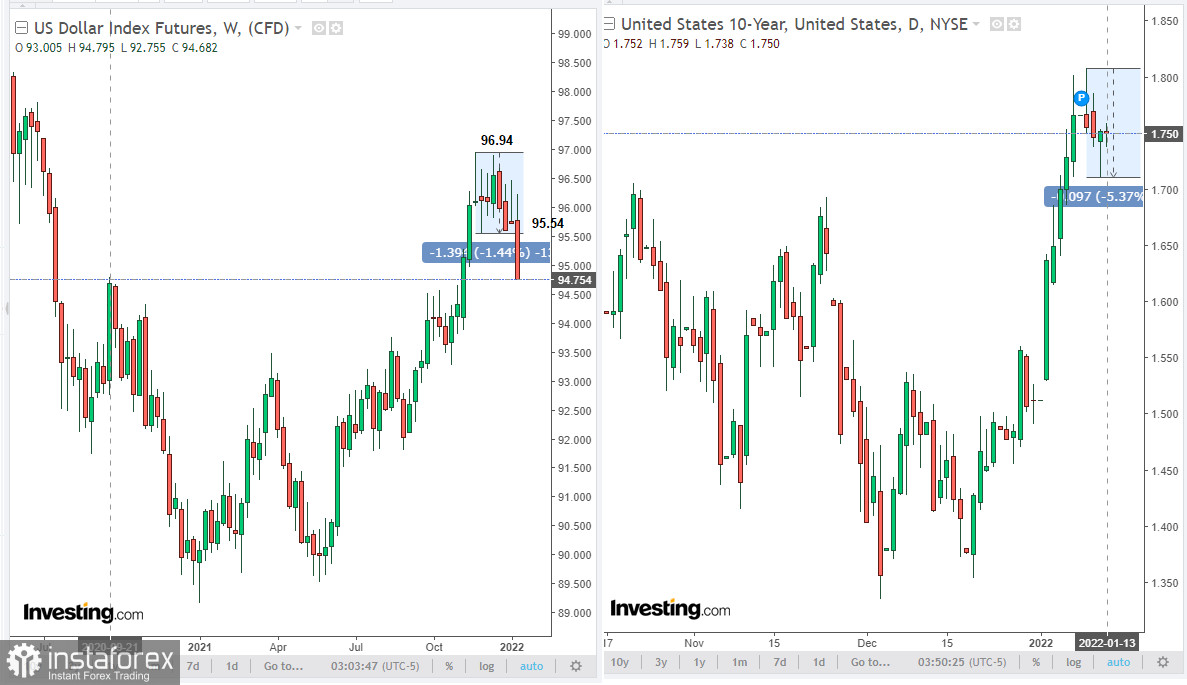
The US Labor Department reported yesterday that consumer prices rose by 7.0% in December on a yearly basis, reaching the highest level since June 1982 (the annual price increase in November was 6.8%). That seems to have cautioned investors. Their negative reaction to US inflation accelerating to its highest level since 1982 means the market has already factored the likely trajectory of Federal Reserve interest rates into US dollar prices, but if inflation continues to rise at the same pace, the Fed may not keep up, rising interest rates in a measured fashion, creating the threat of hyperinflation, which directly affects the value of the US dollar.
According to the CME Group, traders are factoring in the first rate hike in March and expect three to four hikes this year. Immediately after the release of inflation data, the yield on 10-year US government bonds fell slightly below 1.72%, indicating growing concerns about accelerating inflation. At the same time, while 10-year bond yields declined yesterday, today they are near the middle of the range between the recent swing high of 1.808% and yesterday's swing low of 1.711%. Traders are still waiting for the Fed to start reducing its balance sheet (the Fed's balance sheet now estimates at $8.8 trillion) after raising interest rates. The current accelerated reduction in asset purchases by the Fed and expectations of an interest rate hike starting in March are already pushing US government bond yields up. However, if the Fed proceeds to reduce its balance sheet, it may cause the bonds to fall even more and thus the yields to rise, which is likely to strengthen the US dollar.
Federal Reserve Bank of Cleveland President (and a voting member of the FOMC) Loretta Mester said yesterday, she would like to see the Fed start reducing its balance sheet "as soon as possible." Mester noted that measures need to be taken to ensure that inflation declines. "If things looked like they do today in March I would support raising, lifting off from zero at that point," she said, adding that the Fed will raise rates three times in 2022. James Bullard, another member of the Fed's government and head of the St. Louis Fed, said Wednesday that interest rates will need to be raised four times to keep high inflation under control. "We want to bring inflation under control in a way that does not disrupt the real economy, but we are also firm in our desire to get inflation to return to 2% over the medium term," Bullard said.
Investors are assessing the high rate of inflation in the US and the probability that the Fed will have to raise rates more aggressively this year to curb price increases. So far, the threat of higher inflation may weaken the US dollar.
It is possible that the dollar could still weaken for a while until more aggressive signals come from the Fed about the pace and volumes by which Fed interest rates will be raised shortly.
The US dollar quotes factor 3 interest rate hikes (0.25% each) in this year and the acceleration of inflation in the US continues at the same pace, a weakening of the US dollar is highly likely to occur.
 English
English 
 Русский
Русский Bahasa Indonesia
Bahasa Indonesia Bahasa Malay
Bahasa Malay ไทย
ไทย Español
Español Deutsch
Deutsch Български
Български Français
Français Tiếng Việt
Tiếng Việt 中文
中文 বাংলা
বাংলা हिन्दी
हिन्दी Čeština
Čeština Українська
Українська Română
Română

